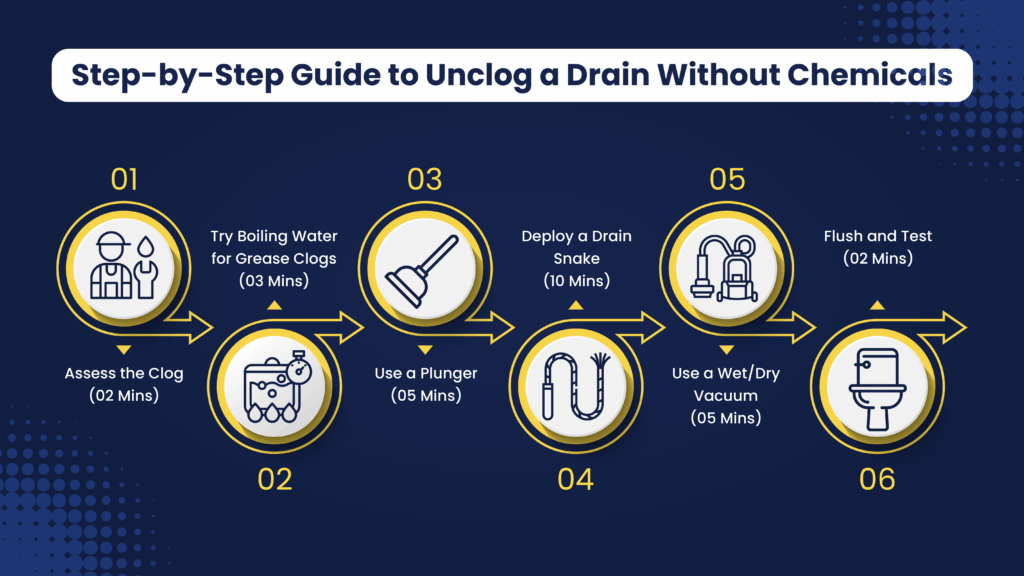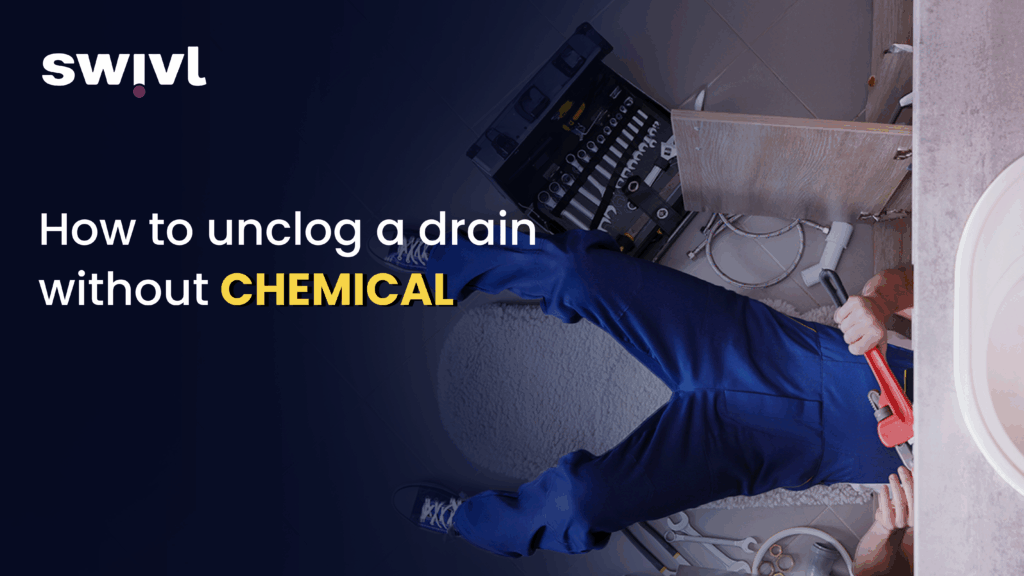Clogged drains are a plumber’s bread and butter, but reaching for harsh chemical cleaners isn’t always the best solution. Chemicals can damage pipes, harm the environment, and pose safety risks. For field technicians, knowing how to unclog a drain without chemicals is a valuable skill that saves time, protects plumbing systems, and impresses eco-conscious clients. This natural drain unclogging methods guide will teach you how to clear clogs using tools and techniques that are safe, effective, and environmentally friendly.
In this troubleshoot clogged drain article, we’ll explore why chemical-free methods matter, the tools you need, and a step-by-step process to unclog drains naturally. Whether you’re dealing with a slow kitchen sink or a backed-up shower, these natural drain unclogging methods will make your workday easier and keep clients happy. Let’s get started.
Why Avoid Chemicals for Drain Unclogging?
Chemical drain cleaners, while quick, have downsides. They can corrode older pipes, especially in homes with galvanized or cast-iron plumbing, leading to costly repairs. They’re also harmful to septic systems and local water supplies, as noted by the Environmental Protection Agency.
For plumbers, unclog drain without chemicals methods offer:
- Safety: No risk of burns or toxic fumes.
- Sustainability: Appeals to green-minded clients.
- Pipe longevity: Preserves the plumbing system.
Plus, natural methods are often just as effective for common clogs caused by grease, hair, or soap buildup. This troubleshoot clogged drain guide focuses on tools and techniques you can trust.
Tools for Natural Drain Unclogging
Gather these essentials for natural drain unclogging methods:
- Plunger: A flange plunger for toilets or a cup plunger for sinks.
- Drain snake (auger): Manual or powered for deeper clogs.
- Wet/dry vacuum: To suck out blockages.
- Bucket and rags: For water cleanup.
- Gloves: To stay sanitary.
- Boiling water kettle: For grease clogs.
For tool recommendations, check our post on how to choose a drain snake for plumbing jobs to find the best auger for your kit.
Step-by-Step Guide to Unclog a Drain Without Chemicals
Follow this troubleshoot clogged drain process to clear clogs naturally, designed for efficiency on service calls.

Step 1: Assess the Clog (2 Minutes)
Start by running water to gauge the clog’s severity. Is the drain completely blocked, slow, or gurgling?
Ask the client:
- What’s going down the drain? Hair in bathrooms, grease in kitchens.
- How long has it been clogged? Recent clogs are easier to clear.
- Any recent plumbing work? This could indicate a deeper issue.
For example, a slow kitchen drain often points to grease buildup, while a shower drain likely involves hair.
Step 2: Try Boiling Water for Grease Clogs (3 Minutes)
For kitchen sinks, boiling water can melt minor grease blockages. Boil a kettle, remove standing water from the sink, and pour the hot water slowly down the drain. Repeat 2–3 times, waiting 30 seconds between pours. This natural drain unclogging method works best for early-stage grease clogs but won’t help with hair or solid debris.
Step 3: Use a Plunger (5 Minutes)
A plunger is your first line of defense for most clogs. For sinks:
- Plug the overflow or second drain (if a double sink) with a rag.
- Add enough water to cover the plunger’s cup.
- Plunge vigorously 10–15 times, maintaining a tight seal.
For toilets, use a flange plunger and ensure water covers the flange. A client’s bathroom sink once cleared after a few plunges revealed a hair-soap combo. If plunging fails, move to the next step.
Step 4: Deploy a Drain Snake (10 Minutes)
A drain snake (or auger) tackles deeper or stubborn clogs. Insert the snake into the drain and crank it slowly to break up or hook the blockage. For:
- Hair clogs: The snake grabs hair for easy removal.
- Grease or soap: It breaks through buildup.
- Foreign objects: It can dislodge small items like bottle caps.
Pull out the snake and clean off debris. I once cleared a shower drain by snaking out a matted hairball, saving the client from a chemical pour.
Step 5: Use a Wet/Dry Vacuum (5 Minutes)
For tough clogs, a wet/dry vac can suck out blockages. Set it to wet mode, create a tight seal over the drain (use a plunger head or rag), and turn it on. This method excels for toilets or sinks with solid debris. Always empty the vac into a bucket to avoid spreading mess.
Step 6: Flush and Test (2 Minutes)
Run hot (not boiling) water through the drain for 30 seconds to flush residual debris. Test by filling the sink or tub and draining it. If it’s still slow, repeat the snaking or vacuum step. A clear drain should empty quickly without gurgling.
Common Clog Types and Solutions
Here’s a natural drain unclogging methods cheat sheet:
- Grease: Boiling water or snaking to break it up.
- Hair: Snake or vacuum to pull it out.
- Soap buildup: Plunge or snake, followed by hot water.
- Food debris: Plunge or vacuum, then advise a drain strainer.
- Mineral deposits: Vinegar soak (not covered here, as it’s semi-chemical).
Keep a variety of drain snakes in your van. Our post on smart plumbing tools for leak detection also covers advanced drain inspection tools.
When to Call for Backup
Some clogs require more than natural methods:
- Main line blockages: Slow drains in multiple fixtures suggest a sewer issue.
- Tree roots: Require professional hydro-jetting or excavation.
- Broken pipes: Need camera inspection and repair.
Explain these to clients and recommend next steps. Our guide on repiping a home step by step can help with major plumbing overhauls.
Tips for Efficient Drain Unclogging
To master unclog drain without chemicals:
- Educate clients: Suggest strainers and regular hot water flushes.
- Stay organized: Keep tools in a dedicated bag for quick access.
- Go green: Highlight eco-friendly methods to win eco-conscious clients.
- Upsell smartly: Pitch maintenance plans. See upselling tips for plumbing technicians.
Avoiding Common Mistakes
Don’t fall for these traps:
- Overusing boiling water: It can crack porcelain if too hot.
- Ignoring deeper clogs: Plunging won’t fix sewer line issues.
- Leaving debris: Clean up thoroughly to maintain professionalism.
- Forcing the snake: Stop if it meets resistance to avoid pipe damage.
Clear Drains the Natural Way
With these natural drain unclogging methods, you can unclog a drain without chemicals safely and effectively. By assessing the clog, using boiling water, plunging, snaking, or vacuuming, you’ll restore flow and impress clients with your eco-friendly approach. Practice these troubleshoot clogged drain steps to make unclogging second nature, and keep your toolkit ready for any challenge.For more plumbing tips, check our blog on how to use customer reviews to market your services to turn happy clients into referrals. Got a tough clog? Share your story in the comments—we’re here to help.




